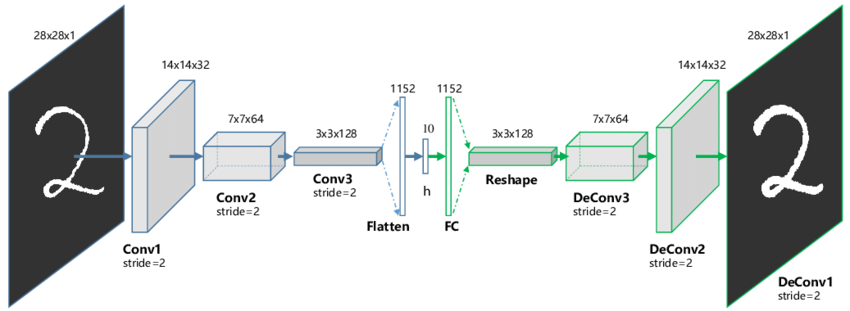This is the 3rd and final project of Software Development for Algorithmic Problems. In this project, we compare 2 different vector space representations for the MNIST image dataset, and evaluate how they perform on nearest neighbor search and clustering.
We used a (mirrored) CNN autoencoder architecture which includes a bottleneck layer in the middle. After training the model, we "feed" each image to the network as input, we take the output of this bottleneck layer and use it as a new vector representation for this image. In our case, this bottleneck layer produces 10 output values so the above procedure can be expressed more formally as a mapping: 784d space -> 10d space :
With the completion of part 1 the new (latent space) representations for the MNIST training and test sets will be stored in the 2 output files specified by the user in the command line. These 2 files are located in output_files/output_dataset_file and output_files/output_query_file respectively.
(update: producing 20 output values instead of 10 in the bottleneck layer seems to be working better)
We have already conducted a similar experiment in Project 1 and we knew that using LSH for Approximate NN Search was already performing very well (~1 approximation ratio and a lot faster than Exact NN search) . This time, we added Exact NN Search in the reduced vector space to our comparisons. Its approximation factor is higher as expected (~1.9), but the search time is almost halved compared to LSH.
In this section, we implemented earth mover's distance and compared it to manhattan distance, our default metric for measuring similarity
between 2 images up to this point. For each image in the query set, its 10 nns are found using both metrics. The files containing labels
are used here in order to measure the accuracy of each approach. It turned out that for MNIST, manhattan distance is both more accurate
and substantially faster.
To compute the earth mover's distance between 2 images, we had to minimize an objective function with respect to some constraints. For this
purpose, google or-tools was used. To download and install OR-Tools for C++, refer to the official installation
page.
In this section, we compared 3 different clustering procedures:
- clustering in 10d vector space + computing silhouette and objective function in 784d vector space
- clustering in 784d vector space + computing silhouette and objective function in 784d vector space
- create clusters using cnn's class predictions for the training set (784d) + computing silhouette and objective function in 784d vector space
The evaluation of each procedure (silhouette and objective) had to be made in the original vector space for our comparisons to make sense. We observed that number (1) produced the worst results, which is something we expected because of the reduced dimensionality of the data. Procedures (2) and (3) performed similarly but (2) achieved slightly higher silhouette score and lower clustering objective value.
For part 1, the program to execute is reduce.py. After navigating to
src/python you can execute the program as:
$ python3 reduce.py --dataset ../../datasets/train-images-idx3-ubyte
--queryset ../../datasets/t10k-images-idx3-ubyte
-od <output_dataset_file>
-oq <output_query_file>
For part 2A, you need to first navigate to the src/cpp/search directory and then execute the following commands:
$ make
$ ./search -d ../../../datasets/train-images-idx3-ubyte
-i ../../../output_files/output_dataset_file
-q ../../../datasets/t10k-images-idx3-ubyte
-s ../../../output_files/output_query_file
-k 4
-L 5
-o output
To delete the generated object files, output file and the executable file simply run
$ make clean
To run part 2B, first make sure you have installed Google OR-Tools for C++ (see
above). Then, navigate to the directory where you installed or-tools (under this directory
you should also see the Makefile as well as the directories examples, include, lib objs, etc) and run:
$ make DEBUG='-Ofast' build
SOURCE=relative/path/to/Comparing_Vector_Space_Representations_for_Images/src/cpp/emd/search.cc
The generated executable file is located by default in the bin directory, so
to execute, run the following:
$ cd ./bin
$ ./search -d relative/path/to/Comparing_Vector_Space_Representations_for_Images/datasets/train-images-idx3-ubyte
-q relative/path/to/Comparing_Vector_Space_Representations_for_Images/datasets/t10k-images-idx3-ubyte
-l1 relative/path/to/Comparing_Vector_Space_Representations_for_Images/datasets/train-labels-idx1-ubyte
-l2 relative/path/to/Comparing_Vector_Space_Representations_for_Images/datasets/t10k-labels-idx1-ubyte
-o relative/path/to/Comparing_Vector_Space_Representations_for_Images/output_files/{output_file_name}
-EMD
Lastly, to execute part 3, navigate to the src/cpp/cluster directory and run:
$ make
$ ./cluster -d ../../../datasets/train-images-idx3-ubyte
-i ../../../output_files/output_dataset_file
-n ../../../output_files/nn_clusters
-c ../../../include/cluster/cluster.conf
-o ../../../output_files/{output_file_name}
